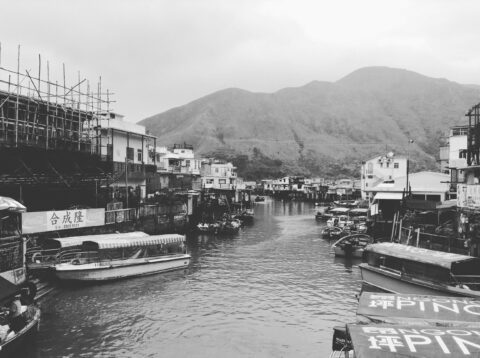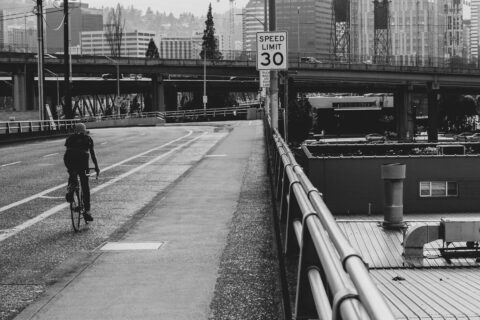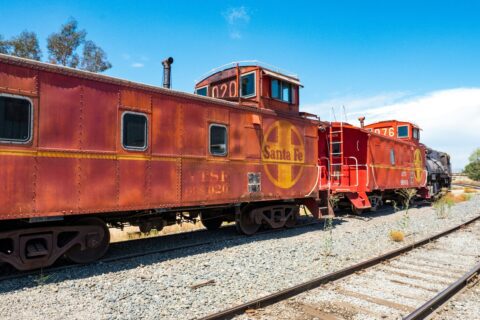Introduction
Welcome to a world where transportation goes beyond the mundane and ordinary! In this blog post, we will embark on an exhilarating journey exploring some of the most unique forms of transportation that exist across the globe. From traditional modes of travel to unconventional and futuristic means, get ready to be amazed by the ingenuity and diversity found in how people get from point A to point B.
Whether you’re a travel enthusiast seeking new adventures or simply curious about what lies beyond your everyday commute, join us as we delve into these fascinating modes of transportation. Buckle up (or maybe not!) as we uncover the extraordinary ways people traverse land, water, and even air. Prepare yourself for an unforgettable ride through time, culture, innovation – all in pursuit of discovering truly one-of-a-kind ways to move around our beautiful planet.
So hop aboard our virtual tour bus as we set off on a thrilling exploration through traditional methods, unconventional rides that defy expectations, and cutting-edge technologies that promise exciting possibilities for future journeys. Get ready to broaden your horizons while satisfying your wanderlust cravings – this is going to be quite the adventure!
Traditional Modes of Transportation
Traditional Modes of Transportation
Throughout history, human beings have relied on various forms of transportation to navigate the world around them. These traditional modes of transportation have served as the backbone of societies for centuries, connecting people and enabling economic growth.
One such mode is the humble horse-drawn carriage. Before automobiles took over the streets, these elegant carriages were a common sight in many cities worldwide. They offered a leisurely way to travel, with their ornate designs and smooth rides.
Another timeless form of transportation is the bicycle. With its simple yet efficient design, it has been a popular choice for individuals looking for an eco-friendly and cost-effective means of getting from point A to point B.
And let’s not forget about boats! From canoes used by indigenous communities to massive cargo ships that traverse oceans, water transport has played a crucial role in trade and exploration throughout history.
We have trains – those iron giants that revolutionized long-distance travel. From steam engines chugging along tracks to sleek high-speed trains reaching incredible speeds today, they continue to be an integral part of our modern world.
These traditional modes of transportation may not be as flashy or innovative as some more unconventional options available today but let us not underestimate their importance in shaping our past and present.
Unconventional Forms of Transportation
Unconventional Forms of Transportation
When it comes to exploring the world, there are plenty of unique and unconventional forms of transportation that can add an extra dash of adventure to your journey. These modes of transport not only get you from point A to point B but also provide a memorable experience along the way.
One such mode is the famous tuk-tuks in Thailand. These three-wheeled taxis may look small, but they pack a punch when it comes to maneuvering through bustling streets and narrow alleyways. Hop on one and zip around cities like Bangkok, feeling the wind in your hair as you navigate through vibrant markets and iconic landmarks.
If you find yourself in Venice, Italy, don’t miss out on experiencing a ride in a gondola. Gliding along the city’s intricate network of canals, these traditional boats offer a romantic and picturesque perspective of this enchanting city. Let your gondolier serenade you with Italian melodies as you soak up the beauty surrounding you.
For a truly magical winter experience, head to Lapland in Finland where reindeer sleds reign supreme. Embrace your inner Santa Claus as these graceful creatures pull you across snowy landscapes – an authentic way to explore this winter wonderland while connecting with nature.
Meanwhile, on the other side of the globe in San Francisco, USA, cable cars offer both transportation and nostalgia rolled into one delightful package. Climb aboard these historic vehicles which have been transporting locals and tourists since 1873! Feel like stepping back in time as they rattle up steep hills offering breathtaking views over this iconic cityscape.
These unconventional forms of transportation showcase just how diverse our world is when it comes to getting around. So next time you travel somewhere new or even revisit familiar destinations seek out these unique experiences for not just reaching your destination but making unforgettable memories along the way!
A. Tuk-tuk in Thailand
When it comes to exploring the vibrant streets of Thailand, one unique mode of transportation that you simply cannot miss is the iconic tuk-tuk. These three-wheeled vehicles are not only a popular means of getting around in busy cities like Bangkok, but they also offer an exhilarating and memorable experience for tourists.
Stepping into a tuk-tuk feels like stepping into a world of its own. As you whizz through bustling streets, the wind rushing through your hair and the sounds of traffic filling your ears, you can’t help but feel a sense of adventure. The open-air design allows you to take in all the sights, sounds, and smells that Thailand has to offer.
Tuk-tuks come in various colors and designs, each with its own personality. From brightly painted exteriors adorned with intricate patterns to eye-catching lights and decorations, these vehicles truly reflect the spirit and charm of Thai culture.
One thing that makes tuk-tuks stand out is their maneuverability. With their compact size and nimble handling, they can effortlessly weave through traffic jams – a skill that drivers have mastered over years of navigating chaotic city streets.
While tuk-tuks may not be as fast or comfortable as taxis or buses, they provide an authentic local experience that is hard to replicate. It’s not just about reaching your destination; it’s about embracing the journey itself.
So next time you find yourself in Thailand, don’t miss out on the opportunity to hop on a tuk-tuk. Whether it’s zipping through busy markets or exploring hidden alleyways, this unconventional form of transportation will undoubtedly add an extra dash of excitement to your travel adventures!
B. Gondola in Venice, Italy
Venice, Italy is known for its picturesque canals and charming streets, but it’s the gondolas that truly capture the essence of this romantic city. These elegant boats have become iconic symbols of Venice and offer a unique way to explore its winding waterways.
Gondolas are traditional flat-bottomed boats that were originally used as a primary mode of transportation in Venice. Today, they serve more as tourist attractions and provide a leisurely way to experience the city from a different perspective.
Stepping into a gondola feels like stepping back in time. The sleek black wooden boat glides silently through the narrow canals, propelled by an expertly trained gondolier who stands at the stern with his long oar. As you sit back and relax on the plush seats, you can admire the stunning architecture of Venetian palaces lining the water’s edge.
While taking a gondola ride may seem like an expensive indulgence, it’s well worth it for the magical experience it offers. Whether you’re on your honeymoon or simply looking to soak up the romantic atmosphere of Venice, gliding along in a gondola is sure to create memories that will last a lifetime.
The gentle rocking motion of the boat combined with soft melodies played by skilled musicians adds to the enchantment of this mode of transportation. It’s no wonder why so many couples choose to take a romantic sunset ride through Venice’s labyrinthine canal system.
However, there are downsides to using gondolas as transport within Venice. They can be quite costly compared to other modes of transportation available in the city such as vaporettos (water buses). Additionally, during peak tourist seasons or busy times like festivals or holidays, finding an available gondola without prior booking might prove challenging.
Experiencing riding in one these iconic vessels is definitely something every visitor should try at least once when exploring this captivating Italian city.
C. Reindeer Sleds in Lapland, Finland
C. Reindeer Sleds in Lapland, Finland
Lapland, a magical region located in the northernmost part of Finland, is known for its breathtaking landscapes and unique cultural traditions. And when it comes to transportation, one mode stands out among the rest – reindeer sleds!
For centuries, the indigenous Sami people have relied on reindeer as their primary means of transport through the snowy wilderness. These gentle creatures are not only well-adapted to extreme cold but also possess incredible strength and agility.
Imagine gliding silently across snow-covered plains while being pulled by a majestic reindeer! It’s an experience like no other, offering a sense of tranquility and connection with nature that is hard to find elsewhere.
The Sami people have perfected the art of handling these magnificent animals over generations. They use traditional wooden sledges called pulks which are specially designed for smooth travel over icy terrain.
Not only do reindeer sleds offer an eco-friendly way to explore Lapland’s stunning natural beauty, but they also provide an authentic glimpse into the rich cultural heritage of this remote corner of Europe.
So if you ever find yourself in Lapland during winter, don’t miss the opportunity to hop on a reindeer sled and embark on a memorable adventure through this enchanting winter wonderland!
D. Cable Cars in San Francisco, USA
San Francisco, known for its iconic landmarks and vibrant culture, also boasts one of the most unique forms of transportation: cable cars. These charming vehicles have been a beloved mode of transport in the city since the late 19th century.
Cable cars are not your typical public transportation. They operate on tracks that run up and down San Francisco’s hilly streets, offering passengers breathtaking views of the cityscape as they glide along. The experience is both thrilling and nostalgic, taking you back to a bygone era.
One fascinating aspect of cable cars is their mechanism. Unlike traditional trains or buses that rely on engines for propulsion, these vehicles are powered by an underground cable system. A motor located at the central powerhouse drives continuous cables beneath the street surface, which in turn pull the cable car along its designated route.
The wooden interiors and open-air design add to the charm of riding a cable car. Passengers can choose between standing outside on small platforms called running boards or sitting inside where it’s cozy and warm during colder months.
Not only are these historic modes of transportation fun to ride, but they also serve as an integral part of San Francisco’s identity. They have become synonymous with this picturesque city and attract tourists from all over who want to experience a unique way to explore its steep hills and scenic neighborhoods.
So next time you find yourself in San Francisco, hop aboard one of these iconic cable cars for an unforgettable journey through history and stunning views!
Modern and Futuristic Transportation
Modern and futuristic transportation has revolutionized the way we travel, taking us beyond the realms of traditional modes. From groundbreaking technologies to innovative concepts, these advancements are paving the way for a new era of mobility.
One such example is the Hyperloop, a high-speed transportation system that uses vacuum-sealed tubes to propel pods at incredible speeds. With its potential to reach speeds of over 700 miles per hour, this mode of transport could drastically reduce travel times between cities and even countries.
Another exciting development is the concept of flying taxis. Imagine soaring through the sky in a compact aircraft, avoiding traffic congestion and reaching your destination in no time. Companies like Uber and Volocopter are already testing prototypes for these autonomous vehicles, promising a future where air taxis become commonplace.
Maglev trains are yet another marvel of modern transportation. These trains use magnetic levitation technology to eliminate friction between train and track, allowing them to achieve mind-boggling speeds. With their smooth and silent operation, maglev trains offer an unparalleled level of comfort and efficiency.
While these modern forms of transportation hold immense promise for the future, they also come with their own set of challenges. The cost associated with developing infrastructure for hyperloops or flying taxi networks can be significant. Additionally, ensuring safety measures are in place is crucial when introducing new modes of transport into our daily lives.
Despite these challenges, it’s clear that modern and futuristic transportation holds great potential for transforming how we move from one place to another. As technology continues to advance rapidly, we can expect more exciting developments on this front in the years to come.
A. Hyperloop
Introducing the Hyperloop, a groundbreaking transportation concept that has captured the imagination of engineers and futurists alike. This innovative mode of travel aims to revolutionize long-distance transportation by propelling passengers through a system of low-pressure tubes at incredible speeds.
Imagine being able to travel from one city to another in mere minutes, reaching speeds of up to 700 miles per hour! With the Hyperloop, this could become a reality. Using magnetic levitation technology, pods would be suspended within the tube and propelled forward using electric propulsion.
One of the most intriguing aspects of the Hyperloop is its potential for reducing travel time drastically. For example, a journey that would typically take several hours by car or train could be completed in just half an hour with this futuristic form of transport.
Not only does the Hyperloop offer immense speed, but it also promises energy efficiency and environmental sustainability. The use of renewable energy sources such as solar power can help minimize its carbon footprint while providing an efficient means of transportation.
While there are many exciting possibilities surrounding the Hyperloop, there are still significant challenges to overcome before it becomes widely implemented. Issues such as safety regulations, infrastructure development, and cost considerations need to be addressed thoroughly.
Despite these hurdles, it’s undeniable that the concept behind the Hyperloop holds immense promise for transforming how we commute between cities. As technological advancements continue to push boundaries in various industries around us – including transportation – we may soon witness a new era where distance is no longer an obstacle but merely an opportunity for adventure!
B. Flying Taxis
Flying Taxis are no longer just a thing of science fiction movies. With advancements in technology, these futuristic transportation options are becoming a reality. Imagine soaring through the sky, avoiding traffic jams and arriving at your destination in record time.
These flying taxis, also known as Vertical Takeoff and Landing (VTOL) vehicles, use electric propulsion to lift off vertically like a helicopter and then transition into horizontal flight like an airplane. They have the potential to revolutionize urban transport by providing a faster and more efficient way to travel within cities.
The concept of flying taxis has gained significant attention from both established companies and startups alike. Companies such as Uber, Airbus, Volocopter, and Lilium are actively developing prototypes and conducting test flights. The goal is to create autonomous or semi-autonomous air taxi services that can be hailed on demand using mobile apps.
One of the main advantages of flying taxis is their ability to bypass congested roads, reducing travel times significantly. They can quickly transport passengers between destinations that would otherwise take hours in traditional forms of transportation. Additionally, they could potentially reduce carbon emissions since many models are designed with electric propulsion systems.
However, there are several challenges that need to be addressed before flying taxis can become commonplace. Safety regulations must be established to ensure passenger safety during takeoff, landing, and flight operations. Infrastructure needs to be developed for landing pads or vertiports where these vehicles can safely land and take off without interfering with other aircrafts.
Despite these challenges, the future looks promising for flying taxis as more research is conducted and technological advancements continue to improve their efficiency and reliability. Someday soon we may find ourselves hailing a ride through the skies rather than sitting in traffic on the ground below!
C. Maglev Trains
Imagine gliding at speeds of over 300 miles per hour, smoothly and effortlessly, with no friction or wheels touching the track. That’s the experience offered by Maglev trains – a revolutionary form of transportation that is changing the way we think about commuting.
Maglev, short for magnetic levitation, utilizes powerful magnets to suspend and propel the train above its tracks. Instead of traditional wheels on rails, these futuristic trains rely on electromagnetic force to hover just above their guideways. This technology not only eliminates the need for physical contact between train and track but also results in reduced noise pollution and improved energy efficiency.
One of the most notable examples of Maglev trains is found in Shanghai, China. The Shanghai Maglev Train connects Pudong International Airport with downtown Shanghai in a mere seven minutes! Passengers marvel at its unparalleled speed as they glide past urban landscapes in a state-of-the-art vehicle.
But it’s not just China embracing this innovative mode of transportation; countries around the world are realizing its potential too. Japan has been experimenting with Maglev technology since the 1970s and plans to have a high-speed line connecting Tokyo and Nagoya operational by 2027.
As exciting as Maglev trains may be, there are still challenges to overcome before they become commonplace worldwide. The cost of building new infrastructure is significant, making it difficult for many countries to adopt this technology quickly. Additionally, safety concerns must be addressed thoroughly when dealing with such high speeds.
Nevertheless, Maglev trains represent an extraordinary leap forward in transportation innovation. With their ability to reach incredible speeds while maintaining comfort for passengers onboard, these sleek vehicles offer us a glimpse into what future travel might look like. It’s an exciting vision that promises shorter travel times and more efficient journeys – truly something worth getting excited about!
Benefits and Drawbacks
Benefits and Drawbacks
As we have explored the world’s most unique forms of transportation, it is clear that there are both benefits and drawbacks to these unconventional modes of getting around. Let’s take a closer look at some of them.
One major benefit of these unconventional forms of transportation is the sheer experience they offer. Whether you’re riding in a tuk-tuk through the bustling streets of Bangkok or gliding along the canals in a gondola in Venice, each mode provides a one-of-a-kind adventure that can’t be replicated elsewhere. These forms of transportation allow travelers to immerse themselves in local cultures and see destinations from an entirely different perspective.
Another advantage is their environmental impact. Many traditional modes of transport rely on fossil fuels and contribute to pollution levels. However, some unconventional options like cable cars and maglev trains use cleaner energy sources, reducing their carbon footprint. This focus on sustainability ensures that future generations will be able to explore our beautiful planet without harming it further.
On the other hand, there are also drawbacks to consider when opting for these unique transportation methods. For one, they may not always be as efficient or practical as more conventional means. While reindeer sleds may offer an authentic Lapland experience, they might not be suitable for long-distance travel or certain weather conditions.
Additionally, cost can sometimes be a factor. Some modern and futuristic options like hyperloop systems or flying taxis may come with high price tags due to their advanced technology and infrastructure requirements. This could limit accessibility for many travelers who are on a tighter budget.
In conclusion (without explicitly stating it), exploring the world’s most unique forms of transportation allows us to step outside our comfort zones while immersing ourselves in new cultures and experiences. From traditional methods rooted in history to innovative technologies shaping future travel possibilities – each option brings its own set of benefits and drawbacks worth considering before embarking on your next adventure!
So why stick with the ordinary when you can embark on a journey like no other? Step off the







